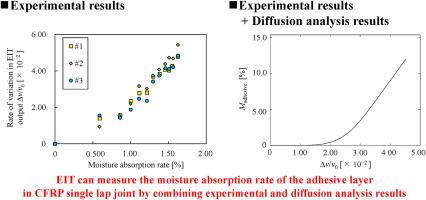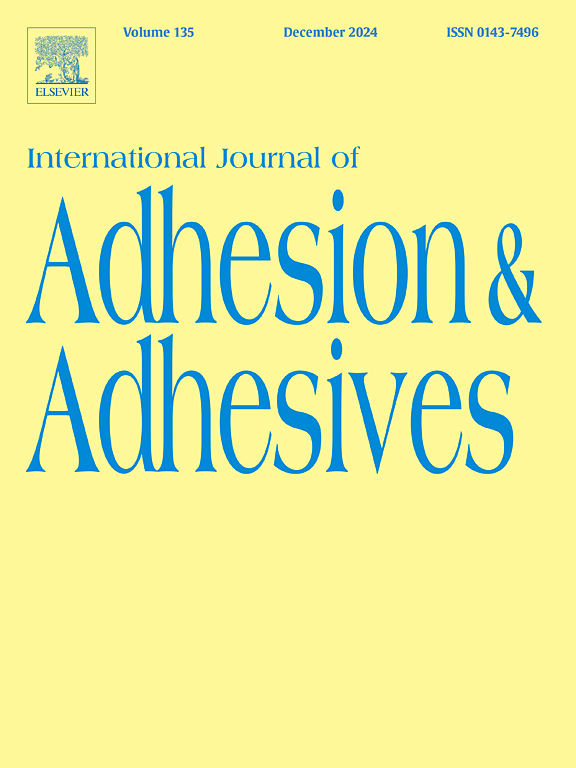Evaluating the moisture absorption percentage in the adhesive layers of carbon fiber reinforced plastic joints via electromagnetic induction testing and diffusion analysis
IF 3.2
3区 材料科学
Q2 ENGINEERING, CHEMICAL
International Journal of Adhesion and Adhesives
Pub Date : 2024-11-06
DOI:10.1016/j.ijadhadh.2024.103883
引用次数: 0
Abstract
In this study, we propose a method that combines moisture absorption analysis and electromagnetic induction testing (EIT) to detect weak bonds formed in the adhesive layers of carbon fiber reinforced plastic (CFRP) joints due to moisture absorption. Although EIT is effective for assessing CFRP joint adhesive moisture absorption, early-stage detection of weak bonds is challenging. Our method addresses this by combining calculations of moisture absorption percentage via the diffusion equation and EIT-based measurements. First, we conducted diffusion analysis using the finite difference method (FDM). The moisture absorption percentage calculated via the FDM was validated by comparing it with the results of the moisture absorption tests of the CFRP adhesive joints, and good agreement was observed. Second, EIT was applied to the CFRP adhesive joints, and the experimental results indicated that the moisture absorption percentage of the CFRP joint can be qualitatively evaluated using EIT. Finally, the moisture absorption of the CFRP joint adhesive layer was quantitatively evaluated by combining the results of EIT on the CFRP joints with those of the numerical analysis. Therefore, the proposed method enables the previously difficult quantitative evaluation of the early-stage moisture absorption percentage of CFRP joint adhesive layers and is effective for the detection of weak bonds created by moisture absorption in CFRP joints.

通过电磁感应测试和扩散分析评估碳纤维增强塑料接头粘合层的吸湿率
在这项研究中,我们提出了一种结合吸湿分析和电磁感应测试(EIT)的方法,用于检测碳纤维增强塑料(CFRP)接头粘合层中因吸湿而形成的弱粘接。虽然电磁感应测试可有效评估 CFRP 接头粘合剂的吸湿性,但早期检测弱粘接却具有挑战性。我们的方法将通过扩散方程计算吸湿百分比与基于 EIT 的测量相结合,从而解决了这一问题。首先,我们使用有限差分法(FDM)进行了扩散分析。通过将 FDM 计算出的吸湿百分比与 CFRP 粘合剂接头的吸湿测试结果进行比较,验证了两者的一致性。其次,将 EIT 应用于 CFRP 胶粘剂接头,实验结果表明,使用 EIT 可以定性评估 CFRP 接头的吸湿率。最后,结合 CFRP 接头的 EIT 结果和数值分析结果,定量评估了 CFRP 接头粘合层的吸湿率。因此,所提出的方法实现了以往难以定量评估的 CFRP 接缝粘合层早期吸湿率,并能有效检测 CFRP 接缝中因吸湿而产生的弱粘合。
本文章由计算机程序翻译,如有差异,请以英文原文为准。
求助全文
约1分钟内获得全文
求助全文
来源期刊

International Journal of Adhesion and Adhesives
工程技术-材料科学:综合
CiteScore
6.90
自引率
8.80%
发文量
200
审稿时长
8.3 months
期刊介绍:
The International Journal of Adhesion and Adhesives draws together the many aspects of the science and technology of adhesive materials, from fundamental research and development work to industrial applications. Subject areas covered include: interfacial interactions, surface chemistry, methods of testing, accumulation of test data on physical and mechanical properties, environmental effects, new adhesive materials, sealants, design of bonded joints, and manufacturing technology.
 求助内容:
求助内容: 应助结果提醒方式:
应助结果提醒方式:


